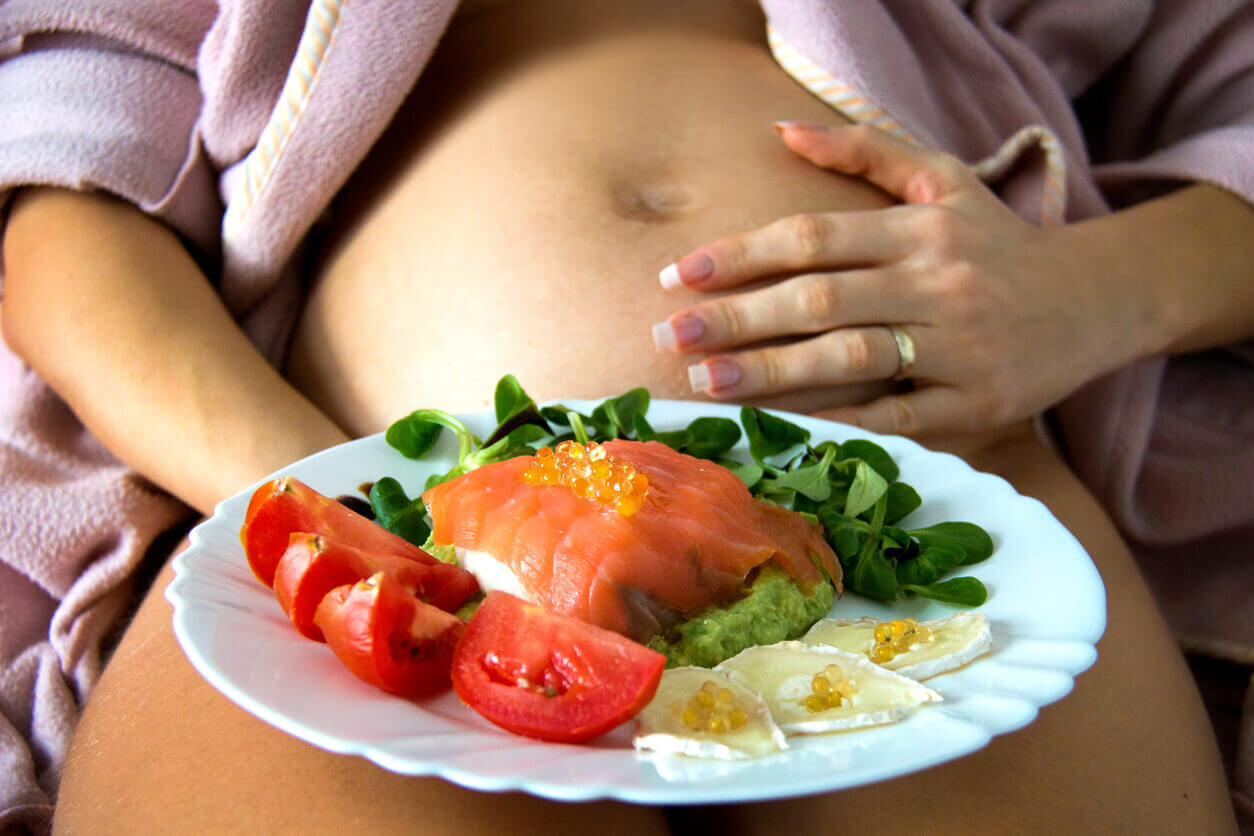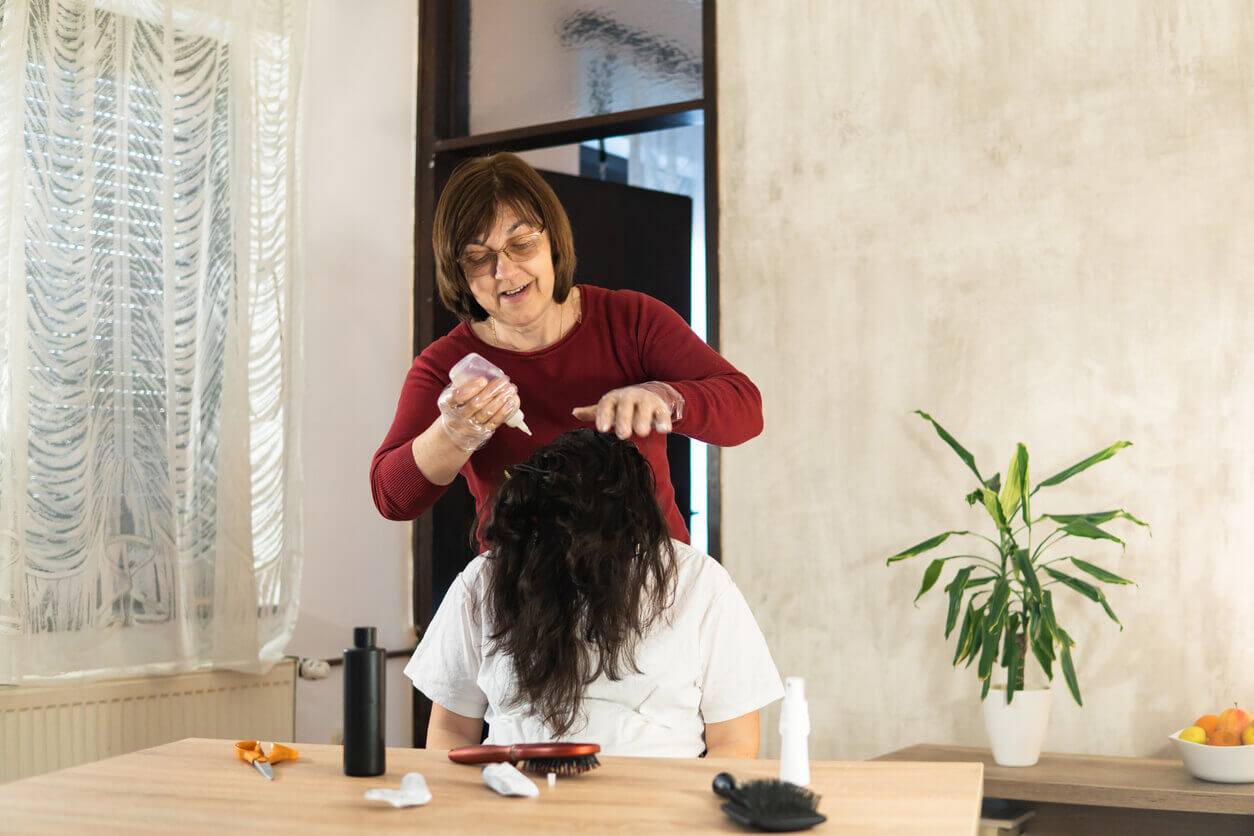How to Take Care of Your Hair During Pregnancy?


Written and verified by the dermatologist Maria del Carmen Hernandez
Hair during pregnancy undergoes significant changes as a result of hormonal alterations. Therefore, to keep it healthy and beautiful, we recommend putting into practice certain care measures.
In this article, we’ll explain how to treat your hair to make it look healthy and shiny.
Hair changes during pregnancy
Hormonal changes that occur during pregnancy affect the hair, making it thinner or thicker. They also change the development cycle of the hair follicles.
Around 15 weeks of pregnancy, hair becomes thicker, as it remains in the growth phase of the cycle for a longer period of time. Therefore, there’s less hair loss than usual.
Another alteration that can be experienced is a change in texture that makes it react differently to various hair treatments. However, when estrogen returns to normal levels after pregnancy, hair loss and normal hair growth can be experienced.
You may be interested in: Oily Hair During Pregnancy: Why and What to Do?

Hair care during pregnancy
The most important thing when it comes to having shiny and healthy hair is to keep the scalp hydrated and healthy to mitigate the effects of hair loss that occur in the postpartum period.
Healthy eating
It’s best to maintain a balanced diet with a high content of vegetables and fruits to help your hair stay strong, stimulate its growth, and provide protection to the hair follicle. At the same time, vitamins and minerals, such as iron, strengthen the hair cuticles and prevent breakage.
Brewer’s yeast is high in vitamin B, which helps to stop hair loss and strengthen hair. In fact, nutrition plays a key role in looking good during pregnancy.
In addition, drinking enough water maintains proper hydration of the skin and body.
Nourishing masks
Hair requires appropriate treatments according to its type, i.e. if it’s dry, oily, or mixed. Moisturizing masks contribute to shiny and hydrated hair, and pregnancy is the perfect time to use them to prepare for the loss of shine in the postpartum period.
Nourishing masks can be applied once or twice a week, leaving them to work on wet hair for at least 20 minutes.
Avoid flat irons or hair dryers
It’s always best to treat hair gently when it’s wet and fragile, as it’s three times more vulnerable to breakage. In turn, wide-tooth combs for detangling hair are ideal.
The use of flat irons or hair dryers is discouraged, or at least their use should be reduced. However, if you need to use irons, dryers, and hot instruments to remove moisture from the hair, it’s best to do so using a lower temperature setting.
In turn, according to recommendations of the American Academy of Dermatology Association, wearing your hair pulled back, or pulling it too tight into braids or ponytails can damage the hair. Therefore, it recommends wearing your hair down to avoid breaking the hair fiber or opting for looser hairstyles.

Avoid dyes
Although hair doesn’t absorb a lot of harmful chemicals from hair dyes, the use of permanent dyes containing ammonia isn’t recommended. Ideally, it’s best to delay coloring until the end of the first trimester according to the American Pregnancy Association.
There are different types of hair coloring, which are characterized by different techniques:
- Permanent hair coloring: This is contraindicated during pregnancy, as its chemicals can have close contact with the scalp.
- Highlights: This type of coloring isn’t as toxic, as only highlights are dyed, and not the scalp.
- Perms and hair styling: It’s advisable to wait until the last trimester to perform these procedures.
If you’re unsure about this, consult your doctor to make sure that the hair treatment is safe to use during pregnancy.
pH-neutral shampoo
It’s a good idea to use warm water to rinse your hair while massaging your hair in a circular motion with your fingertips to stimulate blood circulation in the scalp.
In general, one of the main alterations that hair undergoes is an increase in the release of oil from the scalp. For this reason, for oily hair, mild and pH-neutral shampoos are recommended, while for dry hair, nourishing shampoos and masks are recommended.
A good option is to avoid using shampoos with aggressive ingredients, such as sodium lauryl sulfate or ammonium lauryl sulfate.
Hair during pregnancy and care
In conclusion, whenever it comes to health, the indication of medical professionals is the most recommended. Therefore, consult a specialist to indicate which treatments are allowed during pregnancy.
Hair during pregnancy undergoes significant changes as a result of hormonal alterations. Therefore, to keep it healthy and beautiful, we recommend putting into practice certain care measures.
In this article, we’ll explain how to treat your hair to make it look healthy and shiny.
Hair changes during pregnancy
Hormonal changes that occur during pregnancy affect the hair, making it thinner or thicker. They also change the development cycle of the hair follicles.
Around 15 weeks of pregnancy, hair becomes thicker, as it remains in the growth phase of the cycle for a longer period of time. Therefore, there’s less hair loss than usual.
Another alteration that can be experienced is a change in texture that makes it react differently to various hair treatments. However, when estrogen returns to normal levels after pregnancy, hair loss and normal hair growth can be experienced.
You may be interested in: Oily Hair During Pregnancy: Why and What to Do?

Hair care during pregnancy
The most important thing when it comes to having shiny and healthy hair is to keep the scalp hydrated and healthy to mitigate the effects of hair loss that occur in the postpartum period.
Healthy eating
It’s best to maintain a balanced diet with a high content of vegetables and fruits to help your hair stay strong, stimulate its growth, and provide protection to the hair follicle. At the same time, vitamins and minerals, such as iron, strengthen the hair cuticles and prevent breakage.
Brewer’s yeast is high in vitamin B, which helps to stop hair loss and strengthen hair. In fact, nutrition plays a key role in looking good during pregnancy.
In addition, drinking enough water maintains proper hydration of the skin and body.
Nourishing masks
Hair requires appropriate treatments according to its type, i.e. if it’s dry, oily, or mixed. Moisturizing masks contribute to shiny and hydrated hair, and pregnancy is the perfect time to use them to prepare for the loss of shine in the postpartum period.
Nourishing masks can be applied once or twice a week, leaving them to work on wet hair for at least 20 minutes.
Avoid flat irons or hair dryers
It’s always best to treat hair gently when it’s wet and fragile, as it’s three times more vulnerable to breakage. In turn, wide-tooth combs for detangling hair are ideal.
The use of flat irons or hair dryers is discouraged, or at least their use should be reduced. However, if you need to use irons, dryers, and hot instruments to remove moisture from the hair, it’s best to do so using a lower temperature setting.
In turn, according to recommendations of the American Academy of Dermatology Association, wearing your hair pulled back, or pulling it too tight into braids or ponytails can damage the hair. Therefore, it recommends wearing your hair down to avoid breaking the hair fiber or opting for looser hairstyles.

Avoid dyes
Although hair doesn’t absorb a lot of harmful chemicals from hair dyes, the use of permanent dyes containing ammonia isn’t recommended. Ideally, it’s best to delay coloring until the end of the first trimester according to the American Pregnancy Association.
There are different types of hair coloring, which are characterized by different techniques:
- Permanent hair coloring: This is contraindicated during pregnancy, as its chemicals can have close contact with the scalp.
- Highlights: This type of coloring isn’t as toxic, as only highlights are dyed, and not the scalp.
- Perms and hair styling: It’s advisable to wait until the last trimester to perform these procedures.
If you’re unsure about this, consult your doctor to make sure that the hair treatment is safe to use during pregnancy.
pH-neutral shampoo
It’s a good idea to use warm water to rinse your hair while massaging your hair in a circular motion with your fingertips to stimulate blood circulation in the scalp.
In general, one of the main alterations that hair undergoes is an increase in the release of oil from the scalp. For this reason, for oily hair, mild and pH-neutral shampoos are recommended, while for dry hair, nourishing shampoos and masks are recommended.
A good option is to avoid using shampoos with aggressive ingredients, such as sodium lauryl sulfate or ammonium lauryl sulfate.
Hair during pregnancy and care
In conclusion, whenever it comes to health, the indication of medical professionals is the most recommended. Therefore, consult a specialist to indicate which treatments are allowed during pregnancy.
All cited sources were thoroughly reviewed by our team to ensure their quality, reliability, currency, and validity. The bibliography of this article was considered reliable and of academic or scientific accuracy.
- Hair treatment during pregnancy. [Internet ]Disponible en: https://americanpregnancy.org/healthy-pregnancy/is-it-safe/hair-treatments-during-pregnancy/
- Gavazzoni Dias MF. Hair cosmetics: an overview. Int J Trichology. 2015 Jan-Mar;7(1):2-15. doi: 10.4103/0974-7753.153450. PMID: 25878443; PMCID: PMC4387693.
- 10 hábitos de cuidado del cabello que pueden dañar tu cabello.[Internet ] Disponible en: https://www.aad.org/public/everyday-care/hair-scalp-care/hair/habits-that-damage-hair
This text is provided for informational purposes only and does not replace consultation with a professional. If in doubt, consult your specialist.








